| Reviews & Columns |
|
Reviews DVD TV on DVD Blu-ray 4K UHD International DVDs In Theaters Reviews by Studio Video Games Features Collector Series DVDs Easter Egg Database Interviews DVD Talk Radio Feature Articles Columns Anime Talk DVD Savant Horror DVDs The M.O.D. Squad Art House HD Talk Silent DVD
|
DVD Talk Forum |
|
|
| Resources |
|
DVD Price Search Customer Service #'s RCE Info Links |
|
Columns
|
|
|
Laurence Olivier Presents
THE SHOW:
In the mid-'70s, Laurence Olivier produced and starred in a series of stage plays filmed for Granada Television in the UK. His pitch was to capture the top plays from different periods of 20th century theatre, collaborating with strong actors to bring these works of the stage to the TV audience.
Laurence Olivier Presents is a set of three DVDs with two plays per disc. Adhering to the letter of the text, these productions are less about adapting one medium to another, but rather finding a middle where they meet. This makes the material the star, and gives today's viewers a rare chance to see some of the best actors of the time bring alive some of the finest writers of the seven decades that preceded them.
Disc 1
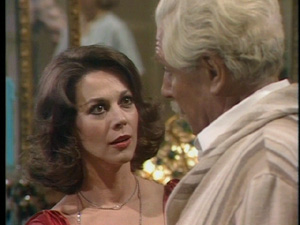
Cat on a Hot Tin Roof
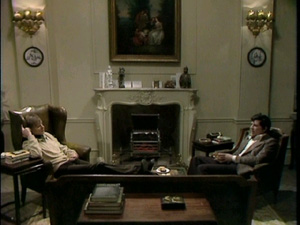
The Collection
* Cat on a Hot Tin Roof, written by Tennessee Williams and first produced in 1955: Natalie Wood fills the formidable negligee of Maggie The Cat. Over a decade past her top roles in movies like West Side Story, Wood still has her chops and is more than up for the sort of bravura performance that Cat on a Hot Tin Roof rises and falls on. Maggie talks practically nonstop, and Wood lives the force of her words, flitting through the character's many moods: strutting, nostalgia, forcefulness, despair, and trickiest of all, compassion. It's to her credit that she inspires the belief that Maggie is, at least in part, sincere.
Wood's real-life significant other, Robert Wagner, plays her onscreen husband, Brick. He withers next to her, completely out of his league. Wagner broods like a soap opera actor, his Brick veneer standing in front of very little. This means Wood is essentially acting alone until Olivier and Maureen Stapleton step into the picture as Big Daddy and Big Mama. Both are fantastic. Olivier makes Big Daddy a real bull of a man, and Stapleton is all emotion and inertia. Unlike the more famous big screen version, the original text is restored for this production of Cat on a Hot Tin Roof, as British television didn't have the same issues with the more scandalous themes the way Hollywood did back in 1958, and so this very dysfunctional Southern family is allowed to tackle their behind-closed-door problems in full.
While performed like a stage production, Cat on a Hot Tin Roof was shot on elaborate sets like the live teleplays of the 1950s. The camera moves around--and often I would guess there was more than one--but the scenes play long, just as they were written. Rather than fancy editing, the shots change in service to the story, propelled by the actors. It's hard to tell how much editing was done after the fact, and how much was done on set. It would be nice if some of the supplemental material let us know if the play was done in one go, or if the director, Robert Moore (Murder By Death), shot coverage. Occasional camera bumps suggest it was done with an eye on keeping the essence of the theatre. Whatever the approach, it keeps the material feeling fresh.
For as much as it works, however, the direction lets the actors down at various times. In a pivotal scene between Maggie and Brick, Moore opts for a point-of-view shot that comes off as cheesy and pushes Natalie Wood to be a little hammy (yes, there's both ham and cheese). Cat on a Hot Tin Roof works best when the camera just hangs back. It's the same in all of the programs in the box: when the text is given a straight delivery, its true power shines.
* The Collection, written by Harold Pinter, 1960 (or, at least 1960 according to the credits; the supplemental information says 1962 for its premiere): Directed by Michael Apted (the Up series, Coal Miner's Daughter), Pinter's scenario of infidelity and intrigue makes for an interesting companion to the Tennessee Williams show. They both have something to do with the way men relate to one another, particularly when their hearts have crossed certain boundaries.
Malcolm McDowell plays Bill, a designer of women's fashions, who lives with a rich benefactor, Harry (Olivier). One day, James (Alan Bates) begins calling and coming around the house, convinced that Bill has had a secret rendezvous with his wife, Stella (Helen Mirren). Bill denies having ever met her at first, but it's really only the beginning of a war of words that will be conducted between all four players. Roles reverse, positions switch, and the truth disintegrates under the various stories each participant tells. In the end, no one knows what really happened, and no one is quite sure how far they might have gone to find out the truth and rub it in the face of their mate.
All the actors are up to the challenge of the roles, relishing in the famous Pinter pauses, and hiding their cards until the time is right to show them. McDowell and Olivier make Bill and Harry the living embodiment of the old adage about the scorpion and the frog. Harry knows Bill will sting him, but he's going to go down defending the boy's right to do it.
Apted adopts a more filmic editing style than Moore did. The Collection's many drawing room scenes are connected by outdoor scenes, something most of the other filmmakers do in their installments, as well.
Disc 2
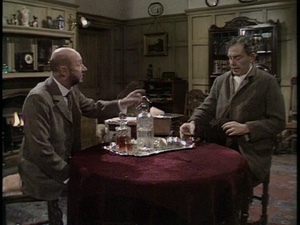
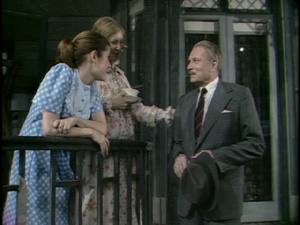
Hindle Wakes, Come Back, Little Sheba
* Hindle Wakes by Stanley Houghton, 1912: This is the only play that doesn't feature Laurence Olivier as an actor, though he and his fellow producer, June Howson, share a directing credit.
Hindle Wakes is a social drama about class hypocrisy and the sliding moral scale applied to gender. Is immoral behavior more acceptable if you have the money to pay for it? Are sexual escapades more okay if you're a man than if you're a woman? These are the questions that come up when Fanny Hawthorn (Rosalind Ayres) returns from Bank Holiday to discover her best friend has been killed and her alibi has been decimated. She was shacked up with the boss' son, Alan Jeffcote (Trevor Eve), and now that their indiscretion is out in the open, the fathers of both children (Jack Hedley and Donald Pleasence) are insistent that the two get married.
The men all react along predictable lines, so the more interesting reactions are among the women. Alan's mother (Rosemary Leach) refuses to believe her son should suffer for a mistake she doesn't even believe he made, while Fanny's mother (Pat Heywood) only wants what her daughter is due. Alan's fiancée, Beatrice (Judi Bowker) rejects his romantic gestures because they chafe against her Christian standards, whereas Fanny has the most surprising--and liberated--response of all.
The drama of Hindle Wakes is the kind of drama that takes place within the walls of family homes when no one else is supposed to be listening. Houghton's dialogue has a natural ring to it, coming across as common speech while still having the poetry of a playwright's construction. The actors inhabit the roles with the same kind of realistic presence, bringing across the air of entitlement in the older characters and the surprising backbones of the younger.
* Come Back, Little Sheba by William Inge, 1950: Directed by Silvio Narizzano (Georgy Girl), this is another play that was shot entirely on an elaborate studio set. Laurence Olivier and Joanne Woodward play Doc and Lola Delaney, an aging couple who have terrible secrets that haunt them. Doc is a recovering alcoholic, one-year sober, and Lola has been torturing herself over the loss of a child several decades before. The title of the play is its central metaphor. Little Sheba is a puppy that has disappeared, and Lola hopes against hope that it will return.
Carrie Fisher is Marie, the Delanies' college-age boarder. She has taken up with the local sports stud, Turk (Nicholas Campbell), who isn't aware that she is also engaged to a businessman who lives out of town (Bruce Boa). Doc and Lola view the younger couple with a lustful eye towards their own lost youth. Marie and Turk remind them of the passionate life they could have had if not for their mistakes. When the fiancée announces he is coming to visit, Marie's deceptions are threatened with exposure, and it unearths something in the Delanies, as well.
It's interesting that so many of these plays deal with sexual trespasses and substance abuse. The material puts a lie to the assertion that the good ol' days stood on much higher moral ground than we do now. Given the nature of the Hays Code, which neutered most of these plays before they could be made into motion pictures, protecting the public from all the sex and booze they weren't having, it seems the real nature of old-time morality is that a sin is less of a sin if you cover it up. Come Back, Little Sheba even makes reference to the Kinsey Report. Anyway, a digression....
Olivier and Woodward are incredible together. She captures Lola's nervous energy to a manic T, and he portrays Doc's quiet shame and eventual decline without hamfisting it. Carrie Fisher is also quite good, lacing her innocent girl act with enough come-ons and innuendos to make it plain why Doc Delaney is so agitated around her. Narizzano applies a fluid direction, giving his actors room to work and subduing any unnecessary histrionics, so that even when events do spin out of control, they remain within the realm of believability. The wounds the characters suffer are tenderly portrayed, making for a powerful finish.
Disc 3
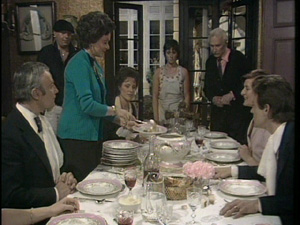
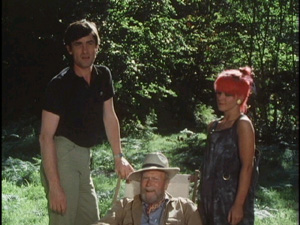
Saturday, Sunday, Monday, The Ebony Tower
* Saturday, Sunday, Monday by Eduardo de Filippo: This Italian family drama was originally written in 1959, but it was not performed in English until 1973. The principle cast of that first UK production reprise their roles here in director Alan Bridges' 1977 version. Laurence Olivier plays Don Antonio, the aging patriarch of a large Italian family. Antonio is no longer as spry as he wants to be, and Olivier gives him a childish self-satisfaction. He lets his limbs get all rubbery, enjoying the doddering gestures of old age and the Italian expressiveness.
The real leadership in the family is Antonio's son Peppino (Edward Woodward) and his wife Rosa (Joan Plowright). All action orbits Rosa's kitchen and her famous Sunday dinners. de Filippo's play tracks the family over three days: Saturday's preparation for the Sunday feast, the big meal, and the Monday morning aftermath. Peppino has been harboring a grudge, and it all comes out over the meal, sparked by the doting neighbor who heaps a little too much praise on Rosa, the son who has become too headstrong for his own good, and a daughter whose own romantic entanglements brings disruption to everyone's digestion.
And that's just the lower branches of this extensive family tree. In all, Sunday's lunch has eleven guests and two servers, all of whom talk at once. Bridges, a television veteran, keeps full control of the chaos, so it never becomes overwhelming for the viewer. All the characters are distinctive enough that they are easy to keep track of, and de Filippo's writing is clear and concise, giving every family member's plight the appropriate emotional resonance. Outside of the opening and closing shots, Saturday, Sunday, Monday is confined entirely to the one residence. This family has to love each other as much as they do, because they've lived on top of one another for a long time.
* The Ebony Tower: The final film of the box is given as a sort of bonus. Produced in 1984, The Ebony Tower was not part of the '76-'77 series of Laurence Olivier Presents. It was never produced for the stage but is an original work for television. The screenplay was adapted by John Mortimer ("Brideshead Revisited") from a novella by John Fowles (The Collector) and directed by Robert Knights ("Monarch of the Glen"). Olivier plays Henry Breasley, a drunk painter who lives in the country with two women, the kind-hearted Mouse (Greta Scacchi) and the punk rock Freak (Toyah Wilcox). The story focuses on the arrival of David Williams (Roger Rees, a frequent guest star on "The West Wing" and "Cheers"), a reporter for an art magazine and a painter himself. He gets sucked into the strange triangle of the three, suffering Henry's abuses and being seduced into a White Knight fantasy by the two girls.
The Ebony Tower definitely suffers in the presence of the company it's keeping. The writing is not nearly up to the standard of the classics presented in the series, and it's shallow and plodding by comparison. The difference in style is particularly evident in the editing and the scoring. The music betrays how hard the filmmakers are pushing to create a sense of weirdness, trying to inspire ominous feelings in the viewer. It falls flat, and in the end, The Ebony Tower feels forced.
Situated in the box as the finale, The Ebony Tower is quite the letdown.
THE DVD
Video:
These productions were shot for television in the 1970s, possibly on video, and sometimes that shows in the way the sets are lit. The picture is full screen with a 4:3 aspect ration. Most of the plays have both interior and exterior shots, and anyone who has seen older BBC productions knows that there is a stark contrast between the clean interior scenes and the more grainy outdoor scenes. Such is the case here, and it should be noted that the exterior scenes have more scratches and surface dirt than the interior. There are occasional transfer glitches in the different plays, including shaky pictures and distortion lines, but they tend to last only for a moment or two. Darker scenes also don't look as strong; the blacks are never solid, making the shadows hazy. Hindle Wakes has the added problem of noticeable ghosting.
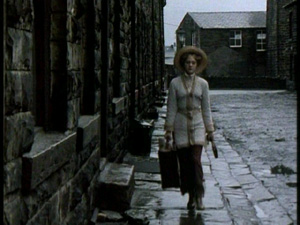
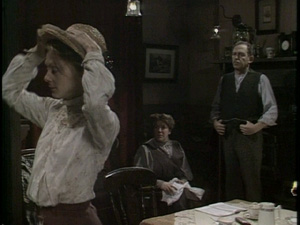
Outside vs. Inside
The picture of Cat on a Hot Tim Roof is a clear exception. It's remarkably preserved, perhaps because it was all filmed in a studio. Outside of the occasional over saturation or shimmering color (Natalie Wood's red dress, slats on the background doors), it looks as good as contemporary productions of plays being shown regularly on PBS.
Come Back, Little Sheba is also shot entirely on set, and so it has one of the better transfers in the collection, as well; however, it has one of the only visible layer shifts I have seen in a long time! At around the eleven-minute mark, as Turk is leaping over a banister, he freezes in mid-air. I was pretty surprised to see it. Later in the film, when Lola is checking the cupboard and makes an important discovery, it looks like the video accidentally slows down. Granted, this is a dramatic "uh oh!" moment, but the jerky nature of the slowing makes me think it's a disc error.
Sound:
The Laurence Olivier Presents DVDs maintain the original sound mix of the television productions, so don't expect your speakers to be dazzled. Interestingly, you can hear the effects of live microphone set-ups, as sometimes there is a loud noise from a prop or an actor's voice drops in or out as he or she moves around in the physical space. None of these moments detract. Quite the contrary! They add to the feeling that we are witnessing a great stage performance.
Extras:
Each disc contains a text biography of Laurence Olivier, filmographies of the actors in the plays, and before you watch each program, you have the option of reading a few facts about the genesis of the material. Unfortunately, in those sections, there isn't much information about the making of the Olivier program. Still, it's nice to get some historical background.
FINAL THOUGHTS:
Highly Recommended. This vintage series is a true score for fans of classic theatre. It's a wonderful opportunity to see some of the finest actors of the time in a handful of the best plays of the 20th century. In particular, Laurence Olivier Presents is one of the finest representations of the producer and lead actor's talent. His versatility with characters and accents will cause you to see clearly why his reputation is so large, and his guiding hand as a producer proves he was just as good at cultivating other people's talent as he was his own.
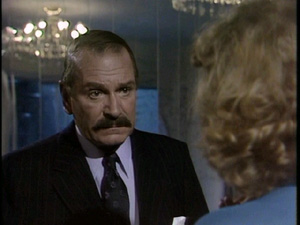
Jamie S. Rich is a novelist and comic book writer. He is best known for his collaborations with Joelle Jones, including the hardboiled crime comic book You Have Killed Me, the challenging romance 12 Reasons Why I Love Her, and the 2007 prose novel Have You Seen the Horizon Lately?, for which Jones did the cover. All three were published by Oni Press. His most recent projects include the futuristic romance A Boy and a Girl with Natalie Nourigat; Archer Coe and the Thousand Natural Shocks, a loopy crime tale drawn by Dan Christensen; and the horror miniseries Madame Frankenstein, a collaboration with Megan Levens. Follow Rich's blog at Confessions123.com.
|
| Popular Reviews |
| Sponsored Links |
|
|
| Sponsored Links |
|
|
| Release List | Reviews | Shop | Newsletter | Forum | DVD Giveaways | Blu-Ray | Advertise |
|
Copyright 2024 DVDTalk.com All Rights Reserved. Legal Info, Privacy Policy, Terms of Use,
Manage Preferences,
Your Privacy Choices | |||||||














